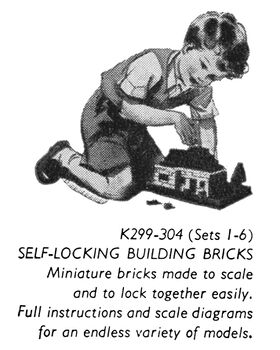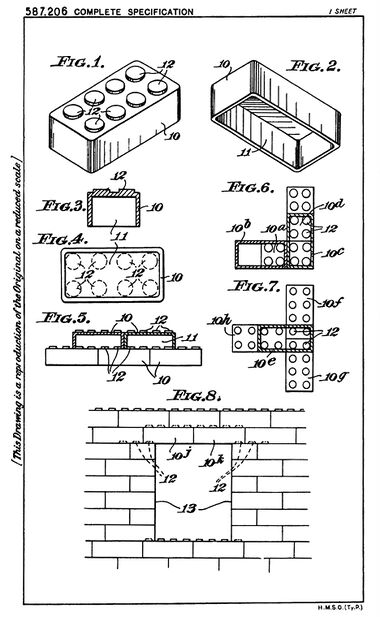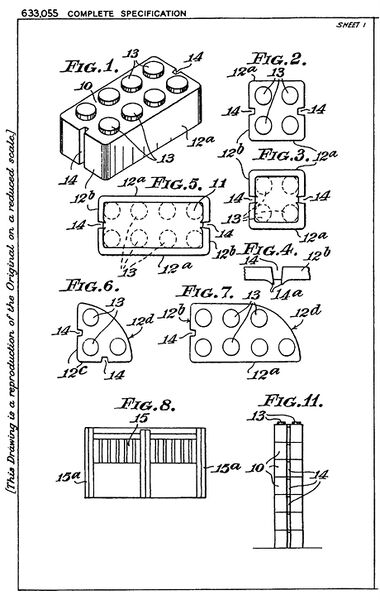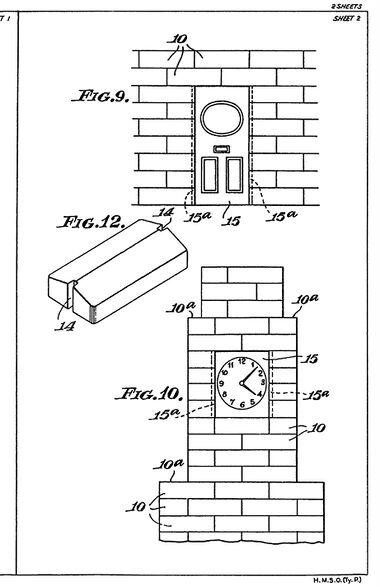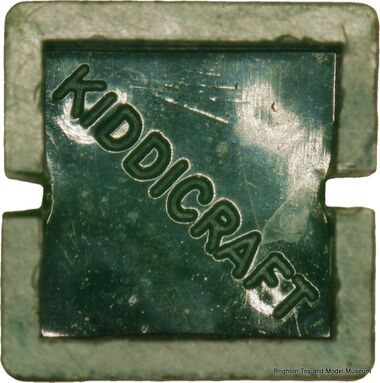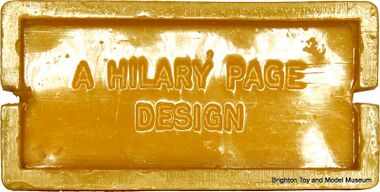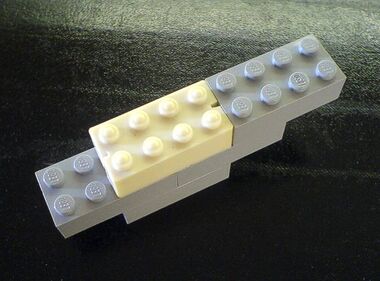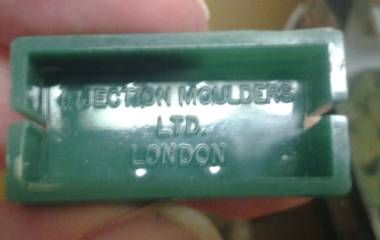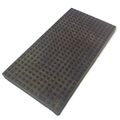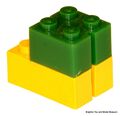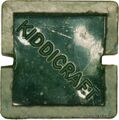Category:Self-Locking Building Bricks (Kiddicraft)
| Toy Brands and Manufacturers |
|---|
Self-Locking Building Bricks (Kiddicraft) |
| 1944 - |
1944: Initial Hilary Page patent, earlier design (granted 1947) [image info]
1945: Hilary Page patent for the final design, with slots (granted 1949) [image info]
1945: Hilary Page patent for the final design (granted 1949) [image info]
A 2×2 brick underside: "KIDDICRAFT" [image info]
A 2×4 brick underside: "A HILARY PAGE DESIGN" [image info]
Lego vs Kiddicraft: Comparison of a ~1947 Kiddicraft Self-Locking Building Brick (white), with some modern 2012 Lego bricks (grey). Any difference in external dimensions is undetectable with a micrometer, and the two sets of bricks interlock just fine. The main difference (other than the slots) is that the Kiddicraft bricks have mildly rounded vertical edges and bobbled tops to make it easier to locate the bricks with their neighbours. The Lego bricks have flat tops (with the Lego logo), and sharp vertical edges (which makes the corners more painful when you tread on them!). [image info]
Self-Locking Building Bricks were invented by Hilary Page and appeared in shops in the late 1940s. The bricks were a development of Page's Interlocking Building Cubes, and were the basis of the modern Lego brick.
The Original Lego
This construction set was the culmination of years of research and R&D by Hilary Page, and the result of a chain of patents on the bricks and improvements and accessories such as baseboards.
However, when a Danish company that made wooden toys decided to investigate the possibility of buying an injection-moulding machine, a sales rep from England took a set of blocks with him from his previous client (Page), and seems to have suggested to the Danes that if their company bought the nice machine, that this was the sort of cool thing that they could make with it.
Lego seemed to agree, and quickly started churning out their own copies of Page's blocks, complete with end-grooves.
Both Page's and Lego's ranges initially faltered, but Lego's range took off after advice from a sales rep, and they started exporting to America. Page, meanwhile, found that his distributors had trouble selling the sets, and he tried to boost the fortunes of his company by announcing an ambitiously large range of dollhouse accessories. Before the range could be completed, a dejected Page killed himself, apparently without realising that the Lego company had been making money from unauthorised copies of his designs.
After Page's death, Lego bought the rights to Page's designs from his daughter. Lego went on to remove the end-slots from their bricks, put their company name of the top of each brick's pegs, and improved the way that the brick bases clipped together. However, the basic design, size and proportions are still recognisably Page's.
Slots
Although Page's initial patent was for a more "conventional" Lego brick, this was followed up by a further patent for an "improved" version with side-slots, and it was this "slotted" version that actually went into production.
The problem faced by Page using early plastics production was the issue of tolerance and grip. In order to grip well (a property now referred to by Lego as having "clutch power"), the space that a brick's studs fitted into had to deliberately be fractionally too small, so that the walls of the receiving brick had to flex to accommodate the stud. This flexing meant that the receiving bricks' wall were effectively "sprung" to grip the stud.
If the space is a perfect fit for the stud, or fractionally larger, the bricks will have a weak grip, worse, fall out when unsupported. If the space is too tight (or the batch of plastic is to hard) the bricks will be difficult to clip together and pull apart. Page's use of cylindrical studs with sides pressed against flat walls gave just about the right amount of friction, and meant that the walls weren't required to flex too much ... getting this right was probably the result of years of experimentation by Page with plastics to find what worked within the tolerances allowed by injection moulding.
As an extra degree of protection from "bad batches" of bricks in the production process and to make the production process more idiot-proof, the last generation of Page's design included end-slots in all the bricks. This allowed a "harder" grip in the microdimensions of the design, alleviated by the increased ability of the brick's side-walls to flex open, thanks to the slot. The grip function was now less susceptible to the effects of tiny variations in the physical properties of the plastics used, as a larger proportion of the effect was now designed into the larger-scale geometry.
The primary object of the present invention is to provide an improved form of building block which enables a built-up column or structure to support vertical sheets or like thin members, which may represent windows, doors, or the like. A further object is to provide a construction in which the blocks will interlock firmly.
...
Further, the blocks will have a degree of resiliency, so that when a block is mounted on another block, there will be a slight opening out due to the slots, and the inherent resilience of the blocks will tend to close the blocks, thus ensuring a firm fit.
— , Hilary Page, , Improvements in toy building blocks patent GB587206, , 1947
When the Lego company originally pirated the design, their bricks kept the Page-patented end-slots. However, as production continued, the Lego bricks were able to do away with the end-slots, and started to include hollow flexible cylindrical protrustions moulded into the base. This meant that instead of pegs being pressed against one side-wall, or two (for a corner) every stud in Lego's new bricks had four regions of contact.
Card inserts
Having decided to "slot" the bricks, Page made the slots an "added-value" feature – the slots could be used to insert small plastic doors and windows (provided) between bricks, but could also be used to insert larger pre-printed card picture inserts.
Strips and Pins
As a final flourish, included thin strips of (incredibly cheap!) wood could be run through a line of bricks and allow the end brick(s) to apparently hover in mid-air unsupported. This allowed a row of bricks to hover above a window-frame or opening (see also the crane arm on Instruction card No.17).
The wood strips were more useful than might first appear, as many of the designs included gaps in the walls for inserting cut-out card signs (e.g. "Post Office"), so in these situations the strips helped to restore structural integrity to a wall that had otherwise been compromised.
A fifth function for the slots (after increasing grip, allowing slot-in plastic accessories, allowing slot-in cards, and allowing the wooden strips) was that one could use them with push-pins to mount rotating cardboard wheels or windmill sails.
Patents
Page applied for a patent for the original Self-Locking Building Brick design in December 1944, which was granted in April 1947, as patent GB587206.
The patent for the slotted version of the brick design was applied for in June 1945, and was granted in December 1949, GB633055
External links
patents
Subcategories
This category has the following 2 subcategories, out of 2 total.
A
- Automatic Binding Bricks - Lego Mursten (Lego) (1 P, 5 F)
M
- Modern Lego Bricks (Lego) (empty)
Pages in category ‘Self-Locking Building Bricks (Kiddicraft)’
The following 4 pages are in this category, out of 4 total.
Media in category ‘Self-Locking Building Bricks (Kiddicraft)’
The following 65 files are in this category, out of 65 total.
- Bakers Shop, Self-Locking Building Bricks (KiddicraftCard 30).jpg 1,586 × 2,200; 2.2 MB
- Bathroom, Self-Locking Building Bricks (KiddicraftCard 38).jpg 1,586 × 2,200; 2.34 MB
- Bedroom Suite, Self-Locking Building Bricks (KiddicraftCard 19).jpg 1,586 × 2,200; 2.28 MB
- Bookcase, Self-Locking Building Bricks (KiddicraftCard 10).jpg 1,586 × 2,200; 2.42 MB
- Box lid label, Kiddicraft Self-Locking Building Bricks, No1 Set (~1947).jpg 3,000 × 1,773; 2.12 MB
- Bridge, Self-Locking Building Bricks (KiddicraftCard 08).jpg 1,586 × 2,200; 2.43 MB
- Cafe, Self-Locking Building Bricks (KiddicraftCard 05).jpg 1,586 × 2,200; 2.16 MB
- Church, Self-Locking Building Bricks (KiddicraftCard 37).jpg 1,586 × 2,200; 2.64 MB
- Clock Tower, Self-Locking Building Bricks (KiddicraftCard 09).jpg 1,586 × 2,200; 2.57 MB
- Clock, Self-Locking Building Bricks (KiddicraftCard 01).jpg 1,586 × 2,200; 2.23 MB
- Crane, Self-Locking Building Bricks (KiddicraftCard 17).jpg 1,586 × 2,200; 2.13 MB
- Dovecote, Self-Locking Building Bricks (KiddicraftCard 27).jpg 1,586 × 2,200; 2.3 MB
- Drawing Room Suite, Self-Locking Building Bricks (KiddicraftCard 14).jpg 1,586 × 2,200; 2.31 MB
- Dresser, Self-Locking Building Bricks (KiddicraftCard 12).jpg 1,586 × 2,200; 2.32 MB
- Engine, Self-Locking Building Bricks (KiddicraftCard 40).jpg 1,586 × 2,200; 2.39 MB
- Fire Station, Self-Locking Building Bricks (KiddicraftCard 22).jpg 1,586 × 2,200; 2.09 MB
- Fireplace Bookcase and Chair, Self-Locking Building Bricks (KiddicraftCard 13).jpg 1,586 × 2,200; 2.25 MB
- Garage, Self-Locking Building Bricks (KiddicraftCard 11).jpg 1,586 × 2,200; 2.38 MB
- Gas Cooker, Self-Locking Building Bricks (KiddicraftCard 23).jpg 1,586 × 2,200; 2.12 MB
- Greenhouse, Self-Locking Building Bricks (KiddicraftCard 45).jpg 1,586 × 2,200; 2.38 MB
- Grocers Shop, Self-Locking Building Bricks (KiddicraftCard 15).jpg 1,586 × 2,200; 2.09 MB
- Gun, Self-Locking Building Bricks (KiddicraftCard 42).jpg 1,586 × 2,200; 2.36 MB
- Hilary Page patent 633055 01 (1945-1949).jpg 1,225 × 1,933; 320 KB
- Hilary Page patent 633055 02 (1945-1949).jpg 1,227 × 1,897; 217 KB
- Hilary Page patent GB587206 (1944-1947).jpg 1,247 × 2,025; 335 KB
- Hilary Page patent GB673857 (1949-1950).jpg 1,399 × 2,200; 460 KB
- House and Garage, Self-Locking Building Bricks (KiddicraftCard 35).jpg 1,586 × 2,200; 2.51 MB
- House with Annex, Self-Locking Building Bricks (KiddicraftCard 39).jpg 1,586 × 2,200; 2.29 MB
- House with Bay Window, Self-Locking Building Bricks (KiddicraftCard 16).jpg 1,586 × 2,200; 2.22 MB
- House with Gable, Self-Locking Building Bricks (KiddicraftCard 26).jpg 1,586 × 2,200; 2.24 MB
- Inner box contents label, Self-Locking Building Bricks, Set No1 (Kiddicraft ~1947).jpg 1,857 × 2,500; 1.79 MB
- Kiddicraft and Lego bricks.jpg 675 × 500; 49 KB
- Kiddicraft base black detail.jpg 1,024 × 768; 75 KB
- Kiddicraft base black.jpg 1,200 × 1,200; 103 KB
- Kiddicraft brick (green) and Lego Mursten brick (yellow).jpg 1,600 × 1,548; 147 KB
- Kiddicraft Bricks card37 church.jpg 768 × 1,024; 51 KB
- Kiddicraft Bricks Injection Moulders Ltd.jpg 380 × 240; 11 KB
- Kiddicraft Bricks introcard.jpg 467 × 650; 51 KB
- Kiddicraft diagram slots.jpg 768 × 1,024; 57 KB
- Kiddicraft Self-Locking Building Bricks, assembled house.jpg 1,200 × 900; 670 KB
- Kiddicraft windows.jpg 497 × 226; 32 KB
- Lioness in Cage, Self-Locking Building Bricks (KiddicraftCard 06).jpg 1,586 × 2,200; 2.69 MB
- Man and Woman, Self-Locking Building Bricks (KiddicraftCard 02).jpg 1,586 × 2,200; 2.24 MB
- Man on a Chair, Self-Locking Building Bricks (KiddicraftCard 07).jpg 1,586 × 2,200; 2.12 MB
- Piano and Stool, Self-Locking Building Bricks (KiddicraftCard 21).jpg 1,586 × 2,200; 2.21 MB
- Pillar Box, Self-Locking Building Bricks (KiddicraftCard 41).jpg 1,586 × 2,200; 2.14 MB
- Post Office, Self-Locking Building Bricks (KiddicraftCard 03).jpg 1,586 × 2,200; 2.31 MB
- Rabbit Hutch, Self-Locking Building Bricks (KiddicraftCard 18).jpg 1,586 × 2,200; 2.15 MB
- Radio and Table, Self-Locking Building Bricks (KiddicraftCard 29).jpg 1,586 × 2,200; 2.28 MB
- Refrigerator, Self-Locking Building Bricks (KiddicraftCard 04).jpg 1,586 × 2,200; 2.29 MB
- Self-Locking Building Bricks, 2x2 underside (Kiddicraft 1947).jpg 1,231 × 1,241; 193 KB
- Self-Locking Building Bricks, Kiddicraft K299-K304 (BPO 1955-10).jpg 950 × 1,186; 324 KB
- Sensible Toys, Kiddicraft (BPO 1955-10).jpg 819 × 1,200; 355 KB
- Signal Box, Self-Locking Building Bricks (KiddicraftCard 25).jpg 1,586 × 2,200; 2.26 MB
- Stables, Self-Locking Building Bricks (KiddicraftCard 20).jpg 1,586 × 2,200; 2.61 MB
- Steamer, Self-Locking Building Bricks (KiddicraftCard 32).jpg 1,586 × 2,200; 2.17 MB
- Submarine, Self-Locking Building Bricks (KiddicraftCard 31).jpg 1,586 × 2,200; 2.27 MB
- Sweet Shop, Self-Locking Building Bricks (KiddicraftCard 24).jpg 1,586 × 2,200; 2.47 MB
- Tank, Self-Locking Building Bricks (KiddicraftCard 43).jpg 1,586 × 2,200; 2.22 MB
- Truck, Self-Locking Building Bricks (KiddicraftCard 44).jpg 1,586 × 2,200; 2.31 MB
- Two Chairs and a Table, Self-Locking Building Bricks (KiddicraftCard 28).jpg 1,586 × 2,200; 2.33 MB
- Two-Storey House, Self-Locking Building Bricks (KiddicraftCard 34).jpg 1,586 × 2,200; 2.21 MB
- Windmill, Self-Locking Building Bricks (KiddicraftCard 33).jpg 1,586 × 2,200; 2.44 MB
- Writing Desk and Chair, Self-Locking Building Bricks (KiddicraftCard 36).jpg 1,586 × 2,200; 2.61 MB
